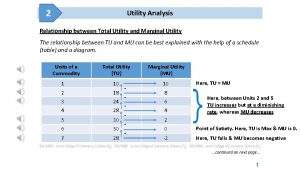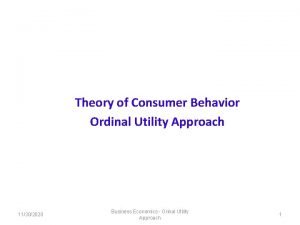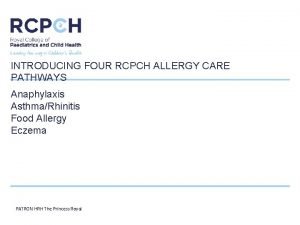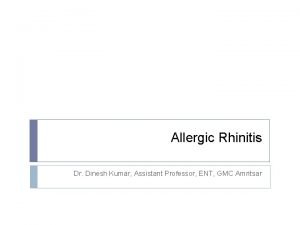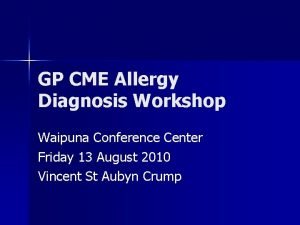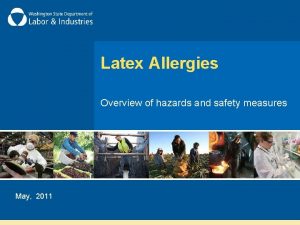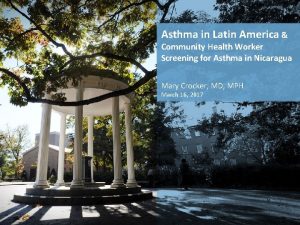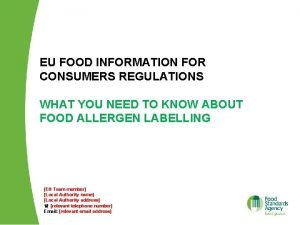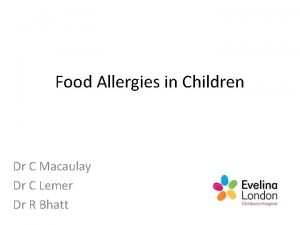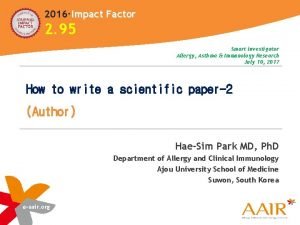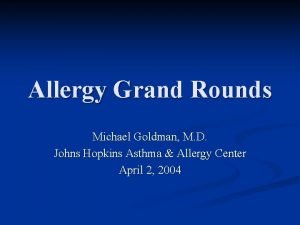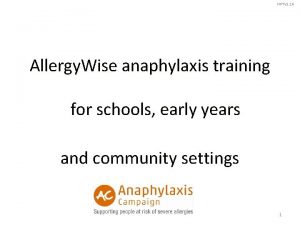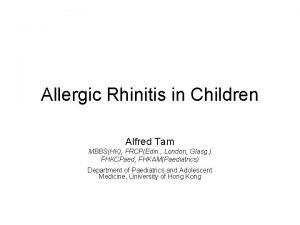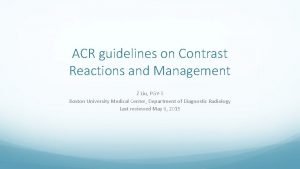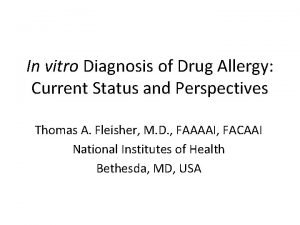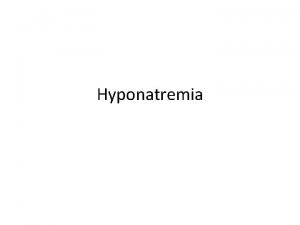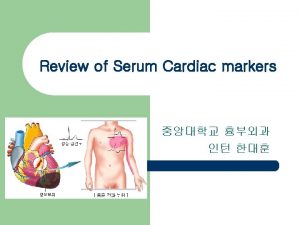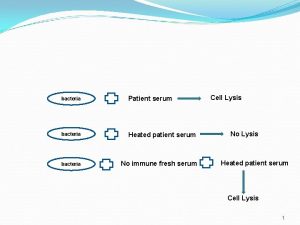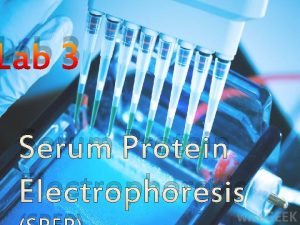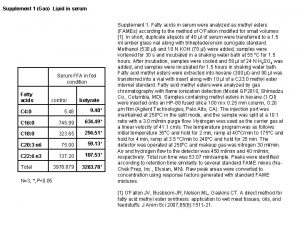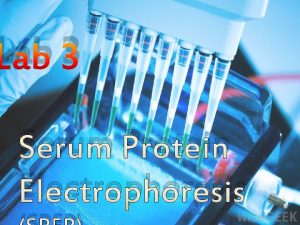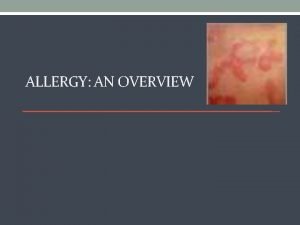Utility of Total Serum Ig E in Allergy























- Slides: 23

Utility of Total Serum Ig. E in Allergy Anne Barasa, MBCh. B, MMed (Path) Lecturer, Immunology Unit Department of Human Pathology University of Nairobi KPA 2019 University of Nairobi ISO 9001: 2008 1 Certified http: //www. uonbi. ac. ke

Immunoglobulin E • 5 th Immunoglobulin class • Once produced, Ig. E binds to its receptors, through which it mediates its functions • High-affinity receptors (FcεRI) - mast cells, basophils, APCs • Low-affinity receptors (FcεRII/CD 23) – B cells, monocytes, dendritic cells • Present in serum in small quantities (0. 0005% of total immunoglobulin) • In equilibrium with that which is cell-bound

Role of Ig. E in Health and Disease • Physiological role – defense against parasites • Helminths • Protozoa • Pathological - Type I hypersensitivity reactions

Pathogenesis of Allergy Re-exposure • Binding of allergen to Ig. E-FcεRI complexes cross-links the receptors, leading to cellular activation • Degranulation & mediator release (histamine) • Synthesis of lipid mediators (prostaglandins, leukotrienes) • Synthesis of cytokines (IL-4, -5) Sensitization

Serum levels of Total Ig. E • Age-dependent • Progressive increase in healthy children, up to age 10 – 15 years • Increase in atopic children is earlier and steeper • Gradual decline from 2 nd decade of life • Should always be evaluated to the reference intervals established from age-stratified healthy (non-atopic) populations

Serum levels of Total Ig. E • Serum levels also influenced by • • • Race Gender Geographic area Season Exposure to environmental pollutants Non-allergic diseases • These make determination of reference ranges difficult • Clinical utility dependent on establishment of reliable reference values for the respective population

Ig. E Levels in Populations in the Tropics • High serum levels of t. Ig. E in people living in helminth endemic areas of the tropics, despite being non-atopic • Helminths capable of inducing Ig. E synthesis markedly • Mostly non-specific Ig. E • Postulated that polyclonal Ig. E synthesis is a mechanism of the parasite to evade the host immune response against it

Causes of Elevated Serum t. Ig. E • Allergic disease • Levels significantly higher in atopic disorders than age-adjusted healthy populations • Significantly increased in parasitic infections (helminths)

Causes of Elevated Serum t. Ig. E • Non-parasitic infections (EBV, CMV, HIV, M. Tb) • Inflammatory diseases (Vasculitides) • PIDs (Hyper Ig. E, Wiskott-Aldrich syndrome) • Malignancies (Hodgkins lymphoma, Ig. E myeloma)

Diagnostic Performance • i. e. . Ability to detect aetiology • Expressed as clinical sensitivity and specificity • Based on a given cut-off value, below which the test is considered negative, and above which it is considered positive • Raising the cut-off makes the test more specific but less sensitive; and vice-versa

6 – 7 yr t. Ig. E cut-off 127. 7 k. U/L 12 – 13 yr 258. 8 k. U/L 38. 4 k. U/L 63 k. U/L Sensitivity (%) 67. 1 48. 7 90. 3 87. 9 Specificity (%) 75. 4 88. 2 52. 8 66. 6 PPV (%) 65. 4 74. 2 70. 0 75. 0 NPV (%) 75. 1 88. 2 81. 6 75. 1 Limited diagnostic value of t. Ig. E despite many patients with allergic disorders having elevated levels

t. Ig. E cut-off 77 k. U/L 164. 3 k. U/L 100 k. U/L Sensitivity (%) 82. 3 61. 2 74. 4 Specificity (%) 87. 1 95. 0 90. 8 PPV (%) 89. 5 94. 3 91. 5 NPV (%) 78. 6 64. 6 72. 5 Insufficient diagnostic accuracy of t. Ig. E levels alone to detect allergic diseases, regardless of cut-off used 77. 7 k. U/L – optimal cut-off on ROC curve 164. 3 k. U/L – upper 95% CI in non-atopic children 100 k. U/L – commonly used cut-off in clinical practice

Total Ig. E n Any s. Ig. E positive < 10 k. U/L 73 3 11 – 20 k. U/L 74 13 21 – 40 k. U/L 74 16 41 – 80 k. U/L 81 22

Clinical Utility of t. Ig. E for Allergy • Commonly requested test as first line test to clarify a state of sensitization, as a risk factor for allergic disease • Higher levels of t. Ig. E in patients with allergic diseases compared with non-allergic patients • Does not prove existence of an allergic disease state • As many as 5% of healthy children may have serum t. Ig. E concentrations above the age-specific reference range • 10% children with clinical signs of hypersensitivity may have serum t. Ig. E concentrations within the age-specific reference range (Some studies report up to 33%)

Clinical Utility • Necessitated identification of cut-off levels to aid in diagnosis of allergy • Cut-off of >200 k. U/L proposed to have high probability in predicting presence of sensitization/allergy

• Positive s. Ig. E findings found in 8% study subjects • Total Ig. E values below 10 k. U/L do not exclude the presence of sensitization • Recommended that s. Ig. E concentrations should be determined in children with low t. Ig. E values in cases of clinically suspect allergic reactions

Clinical Utility - Limitations • Considerable overlap in serum t. Ig. E levels between atopic and non-atopic populations reduces its utility in identifying atopy • Detects total amount of Ig. E present in blood, irrespective of what these Ig. E molecules bind to • Need to distinguish allergen-specific vs non-allergen-specific Ig. E

Clinical Utility in Allergy • Supplemental diagnostic measure for the diagnosis of allergic asthma (Szefler SJ et al, Asthma outcomes: biomarkers; Journal of Allergy and Clinical Immunology; 2012) • Evaluation of candidates for anti-Ig. E therapy

Clinical Governance and Value-Based Care • Lab medicine practitioners take responsibility to ensure cost effective use of lab tests • In children in whom allergy might be suspected but no definite clues exist to explain vague symptoms, a battery of tests (t. Ig. E and s. Ig. E) not recommended • The practice of “over use” of blood screening tests not recommended Sinclair D, Peters SA; J Clin Pathol 2004

Clinical Governance and Value-Based Care • Clinical justification of the test based on careful history and physical examination • Total Ig. E should not be used as a screen for subsequent testing • If the clinical history is of a convincing allergic reaction, a low total Ig. E does not preclude the presence of allergen s. Ig. E • With a history of an acute reaction, proceed with clinically appropriate allergen s. Ig. E tests Sinclair D, Peters SA; J Clin Pathol 2004

Conclusions • Elevated serum Ig. E can be detected in subjects sensitized to allergens, as well as in non-allergic diseases • Measurement of total Ig. E (and then allergen s. Ig. E if the level is above a certain cut-off) has relatively low levels of sensitivity and specificity • High total Ig. E levels do not indicate an allergy • Normal levels do not necessarily indicate absence of allergy

Conclusions • Serum t. Ig. E testing for allergy is non-specific; does not give information on sensitizing allergens • Therefore of limited clinical utility as a screen or diagnostic test for allergic disorders • Replaced by more specific and sensitive markers (s. Ig. E; component resolved diagnostics)

Recommendations • Comprehensive atopic history of the patients • Proper selection and interpretation of specific Ig. E testing • Interpretation within clinical context
 Relation between marginal utility and total utility
Relation between marginal utility and total utility Ordinal utility and cardinal utility
Ordinal utility and cardinal utility Total utility table
Total utility table Rhinitis allergy
Rhinitis allergy Management of allergic rhinitis
Management of allergic rhinitis Penicillin allergy cme
Penicillin allergy cme Latex allergy
Latex allergy Allergy rates
Allergy rates Fsa allergy chef cards
Fsa allergy chef cards Macaulay allergy
Macaulay allergy Allergy asthma immunol res impact factor
Allergy asthma immunol res impact factor Allergy
Allergy Dr adam fox
Dr adam fox Allergy
Allergy Allergy
Allergy Hptv
Hptv World allergy organ j
World allergy organ j Rhinitis allergy
Rhinitis allergy Allergic crease adalah
Allergic crease adalah Acr contrast premedication
Acr contrast premedication Chloraprep contraindications
Chloraprep contraindications Allergy
Allergy Allergy therapy makes bees go away
Allergy therapy makes bees go away Capers allergy
Capers allergy
